THE TISHA B’AV WALK IN THE SPIRIT OF UNITY, BUILDING AND SOVEREIGNTY
Photos:Gershon Ellinson
Thousands took part in the Tisha b’Av Eve March led by the Sovereignty Movement founded by Women in Green and its co-chairwomen, Yehudit Katsover and Nadia Matar. This year marks the half-Jubilee of the renewal of the traditional walk. Among the many participants, the Sovereignty Youth had a significant presence, arriving from all parts of the Land.
The walk began, as it does every year, with the reading of the Scroll of Lamentations (Eicha) at Independence Park in the heart of the capital, and from there it continued to circle the Wall. The walk around the Wall was accompanied by words of explanation and information by historian Arieh Klein on the city’s past, both distant and recent, while passing by notable points on the route around the city’s walls.
Before the walk started, a video was screened with a short speech by Tila Falic Levi, Land of Israel actvist , representing the Falic family who sponsored the Walk. Tila reminded all that the “Tisha beAv fast reminds us of where we come from and what happened to us as a people. Now Am Yisrael is back home in Eretz Yisrael. We learn from many Jewish leaders, from Avraham all the way to Yoni Netanyahu- to be Jews of action. We thank Hashem for the miracle of the Land of Israel and pray for a continued development of Eretz Yisrael, as a unified nation. Am Yisrael Chai”.
Near the Damascus Gate some Arab youths tried to disrupt the walk by shouting epithets, cries of “Allahu Akbar” and clapping of hands, which Nadia Matar “interpreted” in a different way, using the loudspeaker to say “Thanks to all who are applauding on the sidelines because they know that Israeli sovereignty is good for them. Being under Israeli sovereignty is the best thing for them, and if they don’t like it, they are invited to move to Syria…”
The security forces accompanying the walk distanced the Muslim youths , and the walk continued without any other mishaps or friction.
The concluding assembly was held near the Lions’ Gate. Yehudit Katsover began the assembly with words of “special thanks to the security forces and the regional commander, who did not hesitate to approve the walk despite it occurring on the eve of the Muslim Festival of the Sacrifice”.
“It is difficult to imagine how the divided Jerusalem of 52 years ago has become to what we know today, how, from a city, squeezed into a narrow corridor, bounded on all sides, it has become the large and vibrant city of today. Many opponents have arisen and are still arising against the unification of the city in the ideological sense and many more are against the actual unification of the city”, she said, noting how despite everything, different sectors of the population live there together, “Jews and Arabs, religious and secular, new immigrants and seasoned citizens. Jerusalem is gradually taking a central place in the world, in the life of the nation and in the life of the individual”.
On marking the half-Jubilee year of the renewal of the tradition of the walk, Katsover said: “This year we are commemorating the half-Jubilee year of the Walk around the Walls of Jerusalem. A tradition that was renewed 25 years ago by Ruth and Michael Matar, the founders of Women in Green. Twenty-five years in the eternal city are barely a speck of dust in the long and troubled history of Jerusalem. This walk has strengthened and fortified the spirit of the participants and strengthened to status of the city as a sovereignty city”.
The first of the speakers was former minister for Jerusalem Affairs, Ze’ev Elkin, who related: “I have come to this walk as I do every year and this year I have come from a reading of the Scroll of Lamentations in the City of David. There is no place more symbolic than this place to understand the meaning of this year, when on one side there is the Mount of Olives, the most ancient cemetery, where the Shekhina never left Jerusalem after the destruction, and nearby is the mass grave where they buried the victims of the battle in the Jewish Quarter in the War of Independence, when it seemed that the Temple Mount and the Old City had been lost, and on the other side of the same cemetery is the Lions’ Gate, which symbolizes our return in the Six Day War to the same place that was lost in the War of Independence, the way to the Old City, to the Western Wall and the Temple Mount”.
Minister Elkin continued, emphasizing that despite the dramatic change that has occurred over the last decades, “we see that there is still a long way to go. We have sovereignty in Jerusalem and even the nations of the world recognize it when they understand that we are resolute, but there is still some distance to sovereignty in Judea and Samaria as well as full and true sovereignty in Jerusalem, so that this walk will not be only around the Old City, but will be able to continue to the Temple Mount. We have a long way to go in order to assure that those difficult passages in the Scroll of Lamentations will not return”.
As he spoke, Elkin mentioned the murder of Dvir Sorek, Hy”d, who lived north of Jerusalem and studied south of Jerusalem, “our People has lost another wonderful son, a young sweet boy, Dvir Sorek, who gave his life so that someday there will be sovereignty and the Temple will be built and the fast day will become a day of joy”.
Rav Uri Sherki, head of Brit Olam, spoke about the religions “competing” with the Torah of Israel, Christianity and Islam, which claim that they are the true Judaism, a statement that can only be heard when the People of Israel is not in its place. In the spirit of Rav Kook, Rav Sharki said that “When we are in our full power and we have kingship, prophecy and the Temple, others will not be able to claim that they are Israel”.
“Our grief over the destruction is a small echo of the grief from the ideology that seeks to appear again in reality”, said Rav Sherki, adding that it could be that the day is near when joy and gladness will fill the day of Tisha b’Av to the point when we will no longer remember what we grieved over, “it depends on us and our government, our initiatives”, he stated.
Former mayor of Jerusalem, MK Nir Barkat, drew a connection between the unity that accompanied the fighters’ battle for the liberation of Jerusalem and the unity that he wishes for Jerusalem in the political sphere.
“I remember the city before the war and I saw how it developed. I had the great privilege to lead Jerusalem as mayor and contribute my part to the building and shaping of Jerusalem. Over the years we are busy in the mayor’s office networking the city with trains, commercial development, building and housing, increasing tourism, high-tech and other things, but we do not forget our history for a moment. We do not forget what an amazing city it was 3000 years ago when everyone came on pilgrimage and this connected all of the People of Israel; anyone who enters the city feels its holiness and its uniqueness in the world, it is a city that belongs to all of the tribes”.
Barkat noted the importance that he saw, as mayor, to allow every Jew to live anywhere he wanted in Jerusalem, “And fought fiercely for the right to live anywhere, also in Jude and Samaria”, he said, adding that “the challenge is the de facto realization of sovereignty in the field”.
As noted, Barkat made a connection between Jerusalem, unity of the People and the political issue: “As mayor, I made a great effort to establish a broad coalition and we found a very broad common denominator in Jerusalem belonging to everyone. We must seek the broadest common denominator in Israel. After the elections we will have to see how we can integrate as many groups of the public as possible in the coalition and increase ahavat chinam- ‘causeless love’”.
Later during the assembly, Minister of Transportation Bezalel Smotrich spoke, describing his route to the assembly from his house in Kedumim and his sense, as one who travels in a government vehicle on crowded roads with communities on the sides of the roads and he enters a city crowded by traffic and many people – no longer desolate, however, he also is reminded by the presence of the police jeep escorting the government vehicle and the reason for it that there is still need for such security escort.
“We are an independent and sovereign state, but we are still threatened, we fight and we struggle, but mainly, we haven’t the heart, we lack the essential root and the connection of who we are and what we are doing here in the Land of Israel. We don’t have the Temple and this is not just a technical matter, we lack the stature and wholeness of the process that we are now in the midst of. The Almighty is returning the Temple in a lengthy process, but it is not yet here. We must mourn over the fact that we don’t even know how to feel the lack and the significance of the nearness of G-d and the presence of the Shekhina, what this would mean for all the reality of our life, if we could feel the tangible presence of the Almighty, what that would do to us, to our enemies, to our leaders. What faith, ability and resolve to do things so much better if we understood what we are doing here and the meaning of a ‘kingdom of priests’ and a holy nation”.
Smotrich called for such strong and palpable consolation that it would have the power to console even those who were there then, 1950 years ago, and saw the events of the Scroll of Lamentations happening before their eyes. “This is how we must act in our generations along with the Almighty to bring full consolation, ‘And you will build in with fire in the future’”.
Another speaker at the assembly was former member of Knesset Orit Struk, who mentioned that the mourning of Tisha b’Av began considerably before the destruction of the Temple. The mourning began with the sin of the spies, when it was determined that because the children of Israel cried, they will cry for generations.
“This walk is the rectification for the sin of the spies”, Struk declared, noting the completion of 25 years since the renewal of the traditional walk. “Twenty-five years ago, the sin of the spies in our generation occurred, the terrible Oslo Accords which showed an aversion to the pleasant Land and the sense that we cannot hold onto the Land because the people here are stronger than we are. This is the Oslo Accords, which began all of the withdrawals, the last of which was that of Tisha b’Av 14 years ago, the expulsion from Gush Katif”.
Turning to Yehudit Katsover and Nadia Matar, Struk said: “You began with another banner but today’s banner is clearer more prominent – the banner of sovereignty, which is the rectification for the sin of the spies. A banner that says that the Land is very, very good and we love the Land and even if it is difficult, we can overcome these difficulties because the Land is very, very good”.
Aryeh King, a member of the Jerusalem Council and one of the city’s builders, also spoke, beginning with a grim testimony of the present reality. He turned the attention of the massive audience to a stone in the wall near the road, with Arabic inscription. This is a street sign, he said, that the government of Turkey set up on the day after the Marmara incident. “The government of Israel knew about it and knows today as well. This is not sovereignty!”
“We speak of unity but unity must be behind the holy and not compromise the holiness of Jerusalem”, said King, returning to the sad description of the situation today: “These days, there are areas where, if you are a Jew, you are not permitted to enter”, he said, mentioning the neighborhoods where only Arabs are allowed to build, such as Giv’at Hamatos and the neighborhood of Shimon Hatzadik.
King mentioned the days of his childhood in Kibbutz Alumim where it was possible to hitchhike from Gaza and from Masajiyya without any problem at all, when the beach in Gaza was a recreation place for the Jewish children of the area, but within just 11 years the situation has changed, at first the IDF was removed from the centers of the cities, later checkpoints were set up and even later came the expulsion of the Jews.
King praised the efforts of the former minister of Jerusalem Affairs, Ze’ev Elkin, to strengthen the City of David, the Mount of Olives, the presence in Tzidkiyahu’s cave and other things, but to this he added: “I find it unfortunate that we do not relate to all of Jerusalem as an integral part of the heart of the Jewish People”.
The final speaker was Atty. Nili Naouri, director of Israel Forever, who expressed the hope that in the coming year it will no longer be necessary for the walkers to have a security escort.
“It has already been 52 years and we still need a security escort. This is because there are those to whom it is still not clear that we are the sole, legitimate owners of this Land and when we do not behave like the owners, the Arab invader behaves like the owner”.
“When the Romans destroyed the Temple, they changed the name of the Land of Israel to Palestina and the name of Jerusalem to Aelia Capitolina to nullify the connection of the People of Israel to its Land”, Nahuri declared, adding: “Today they speak of ‘territories’ and the ‘west bank’ but this is Judea and Samaria, an area that is exclusively Jewish, the cradle of the People of Israel. For two thousand years of exile we have become accustomed to depending on the good will of the non-Jews and have repeated the sentence ‘Next year in rebuilt Jerusalem’. We have to take the exile out of the Jews, to become accustomed to behaving once again as the sovereign. Enough of the status quo. The time has come for sovereignty”, she declared.
Before the conclusion of the event, Yehudit Katsover and Nadia Matar mentioned Jonathan and Esther Pollard, praying for a speedy refua shlema (recovery) for Esther and praying to see Esther and Jonathan finally coming on aliya to Israel.
The event concluded with a screening of a movie that was prepared especially for the event, entitled ‘From Dust to Glory’, which skipped quickly from the events of the destruction and the exile to the building and revival of these days. The English version of the movie will be posted soon on the Women in Green and Sovereignty website, meanwhile here is the Hebrew version:
At the end of the film’s screening many of the participants of the walk continued to the heart of the Old City and the additional lamentations at the Western Wall Plaza.
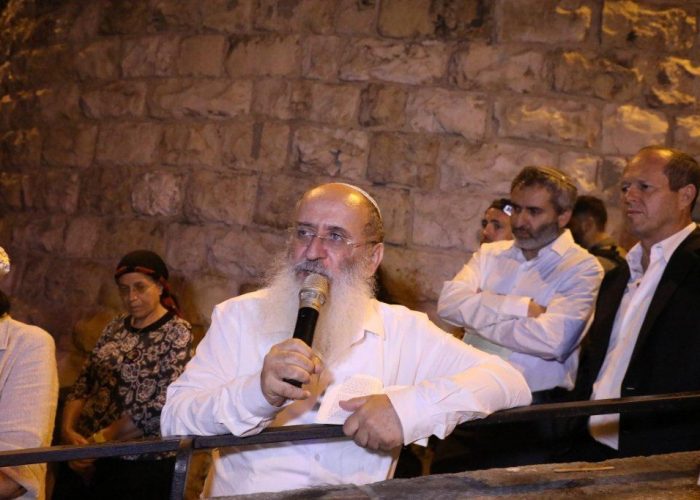
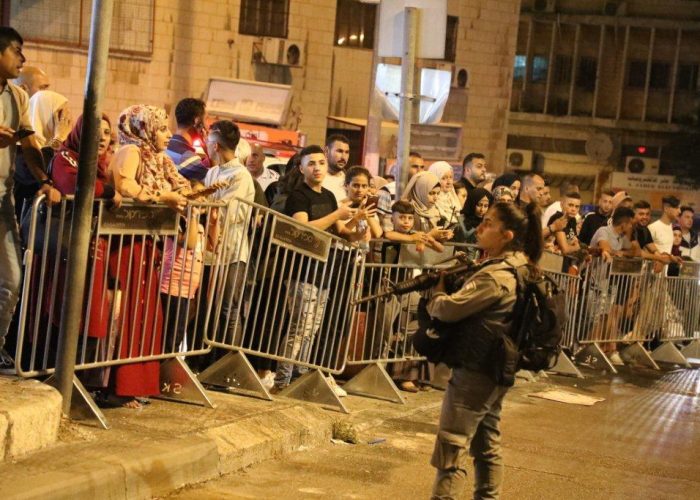
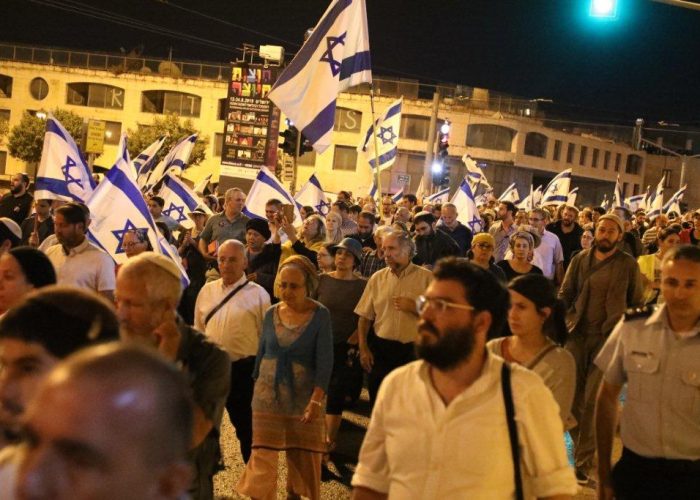
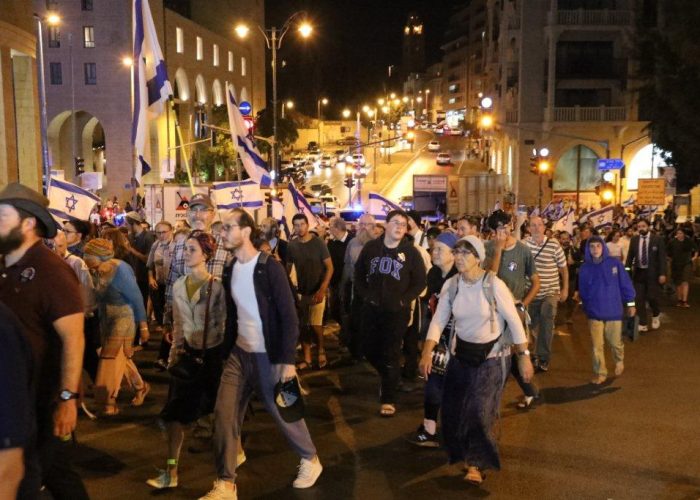
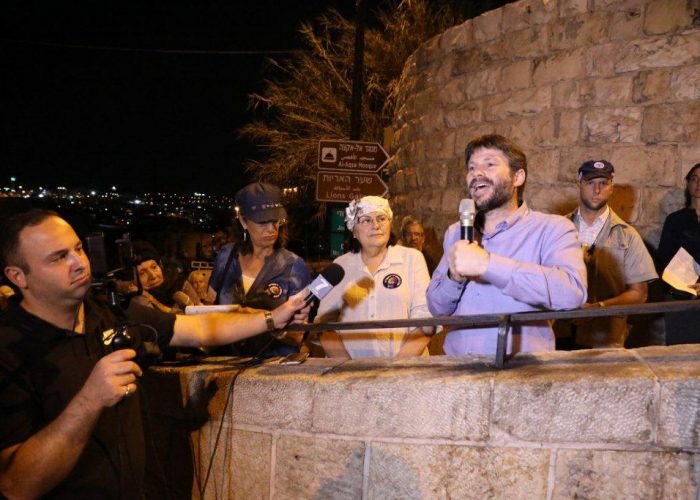
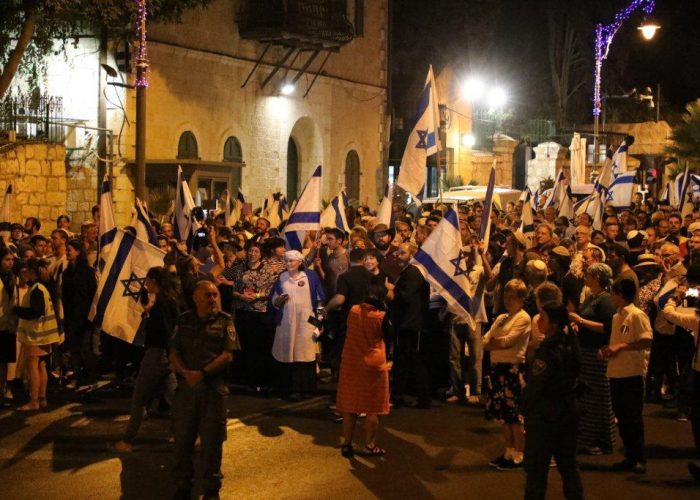
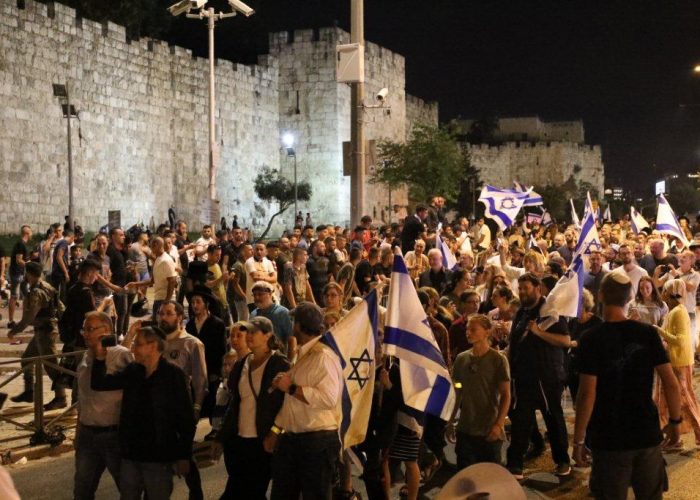
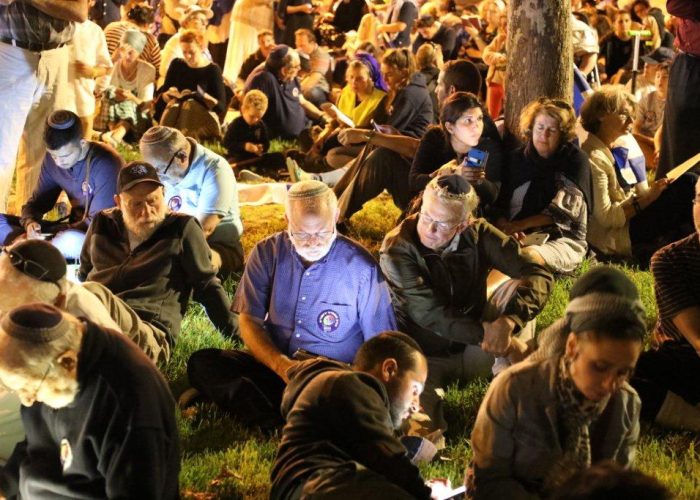
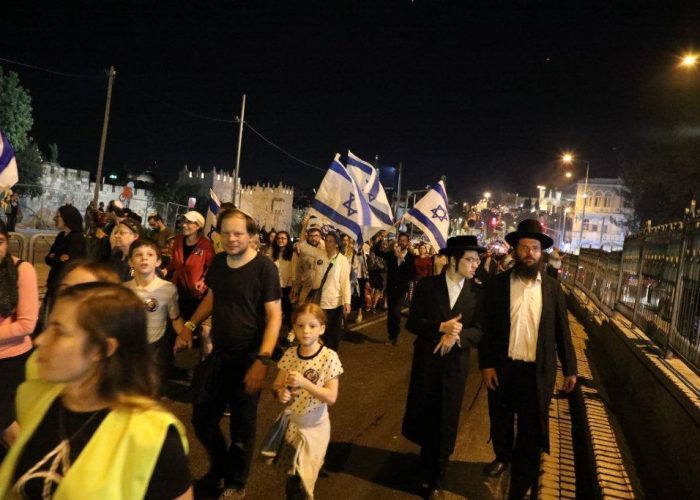
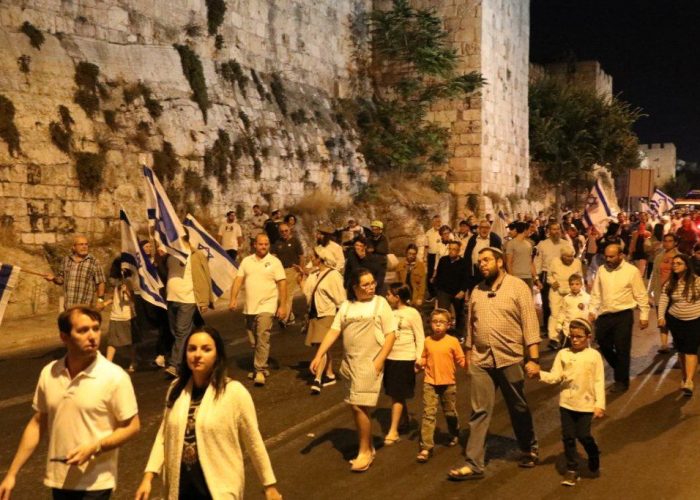
No comments:
Post a Comment